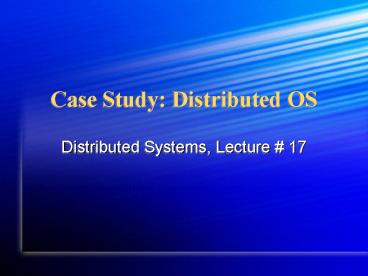Case Study: Distributed OS - PowerPoint PPT Presentation
1 / 17
Title:
Case Study: Distributed OS
Description:
Title: Case Study: Distributed OS Author: Umar Saif Last modified by: Umar Saif Created Date: 5/8/2006 7:29:00 AM Document presentation format: On-screen Show – PowerPoint PPT presentation
Number of Views:76
Avg rating:3.0/5.0
Title: Case Study: Distributed OS
1
Case Study Distributed OS
- Distributed Systems, Lecture 17
2
Amoeba OS
- What if we could afford hundreds of computers per
user? - Use a shared pool of servers
- These days this is called blade computing
- Grid Computing?
- Location independent
- Amake
3
Architecture
4
Micro-kernel
- Process and thread (kernel/user space) management
- IPC
- Low level I/O management
- Low level Memory management
5
Client-Server Model
- Clients are written by users
- Servers are written by system programmers
- Essentially isolating faults, and reliability
guarantees
6
Objects
- Servers manage objects
- Clients can instantiate and access objects
- Objects protected by cryptographically protected
capability - Files
- Directories
- Memory Segments
- Screen Windows
- Processors
- Disks
7
RPC Communication
- Primitive for location independence
- Stub acts as a proxy in the client address space
- Resolve name
- Marshal parameters
- Block for reply
8
Bullet Soap Server
- Modular Architecture
- Naming
- File Manipulation
- Bullet File server
- Read-only file server
- Files can only created and deleted
- Not modified!
- Soap Directory Server
- Maps file names to capabilties
9
Other Servers
- Object replication server
- Process maintenance
- Health-monitoring server
- Inter-operability servers
10
Objects and Capabilities
- Objects make the system modular
- Secure
- Fault-tolerant
- More available
11
Capabilities
- Naming as well as protection
- Managed in user space
- Rights management
- Can downgrade rights of a capability
- Takes original bits
- XOR with old rights
- Take a one-way hash
12
Process Management
- Process is also an object
- Accessed by process descriptor capability
- Three-levels of interfaces
- RPC with process servers
- Library Calls
- Do-all dispatcher Run-server
13
Memory Management
- Not paged or swapped
- Contiguous in memory
- Segments may be created, destroyed, read and
written - Simple and fast in an RPC model
- Overly restrictive
14
Message passing
- Servers declare ports
- Get_port
- Identifies a service
- Clients put-ports in their messages
- At-most once semantics
- As opposed to atleast once
15
Group Communication
- Closed groups
- Reliable Broadcast
- Sequencer model
- Lazy-ack
- Client broadcast vs Sequencer broadcast
16
Layered Communication Model
- LAN
- IP
- FLIP
- Fast local internet protocol
- FLIP addresses are persistent and
location-independent - From the put-port to the FLIP address
- From the FLIP to the network address
17
(No Transcript)































